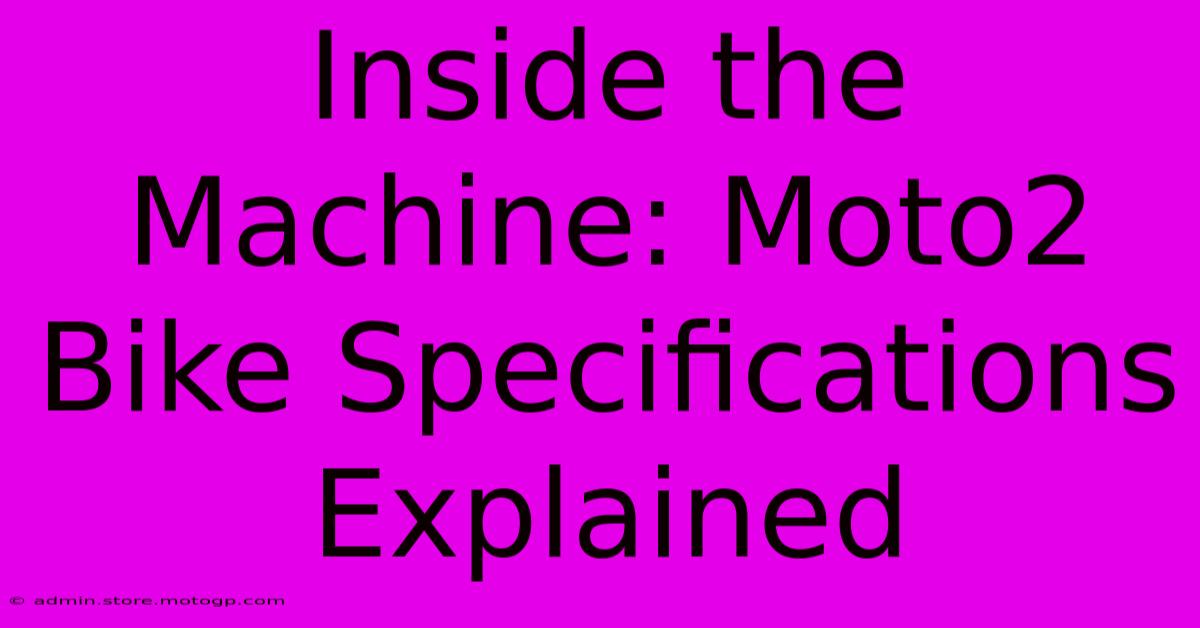Inside The Machine: Moto2 Bike Specifications Explained

Table of Contents
Inside the Machine: Moto2 Bike Specifications Explained
The Moto2 class, a crucial stepping stone in the Grand Prix motorcycle racing world, boasts incredibly sophisticated and meticulously engineered machines. Unlike MotoGP, where manufacturers compete with unique designs, Moto2 utilizes a single engine supplier, ensuring a level playing field focused on rider skill and team strategy. This standardization, however, doesn't diminish the complexity or intrigue of these high-performance motorcycles. Let's delve into the key specifications and components that define a Moto2 bike.
The Heart of the Beast: The Engine
The beating heart of every Moto2 bike is a Triumph 765cc inline-three cylinder engine. This engine, a derivative of the Street Triple RS, is a marvel of engineering, specifically tuned for the demands of racing. Key features include:
- 765cc Displacement: This provides a healthy power output without excessive weight.
- Inline-Three Cylinder Configuration: Offers a smooth power delivery and manageable engine characteristics.
- High RPM Capability: These engines rev to incredibly high RPMs, maximizing horsepower throughout the rev range.
- Sealed Engine: A crucial aspect of the spec regulations, ensuring fairness and preventing teams from modifying core engine components.
This standardized engine ensures competition is fiercely focused on chassis setup, rider skill, and team strategy rather than engine development.
Chassis Dynamics: The Foundation of Performance
The chassis plays a vital role in a Moto2 bike's performance. While the engine is standardized, teams have significant freedom in configuring the chassis to suit their riders and track conditions. Key elements include:
- Frame: Typically constructed from aluminum, the frame is designed for optimal rigidity and flexibility, allowing for precise handling. Different manufacturers utilize varying frame designs, impacting handling characteristics.
- Swingarm: Similar to the frame, the swingarm significantly influences handling. Different designs and materials can influence traction and stability.
- Suspension: Teams have considerable leeway in selecting and setting up the suspension components (front forks and rear shock). This is a critical area where teams can gain a competitive edge. Brands like Ohlins and Showa are common choices.
- Brakes: High-performance braking systems are essential for Moto2 racing. Brembo is the dominant supplier, offering powerful and reliable stopping power.
- Wheels: Lightweight wheels, often made from magnesium or carbon fiber, minimize unsprung mass, improving handling and responsiveness.
The interplay between these chassis components is crucial in delivering optimal performance. Teams employ sophisticated data acquisition systems and analysis to fine-tune these settings.
Electronics and Aerodynamics: Refining the Edge
Modern Moto2 bikes leverage advanced electronics and aerodynamics to achieve maximum performance:
- ECU (Engine Control Unit): A sophisticated electronic control unit manages various engine parameters, allowing for precise tuning and optimization. While the engine is sealed, the ECU allows for some level of adjustments within the specified parameters.
- Magneti Marelli Software: The ECU uses specialized software from Magneti Marelli, a leading supplier of motorsport electronics.
- Aerodynamics: While not as extensively developed as in MotoGP, aerodynamic components like fairings and winglets play a subtle but important role in high-speed stability and cornering performance.
These seemingly minor details contribute significantly to lap times and overall competitiveness.
Tires: The Crucial Contact Patch
Moto2 utilizes Dunlop tires, specifically designed for the demands of the championship. Tire choice and management are critical strategic elements throughout a race weekend. The performance and longevity of these tires significantly impact race strategy.
Conclusion: A Symphony of Engineering
The Moto2 bike is a testament to the sophisticated engineering and technology behind Grand Prix motorcycle racing. While the standardized engine ensures fair competition, the flexibility in chassis setup, electronics, and tire management creates a dynamic and exciting racing environment where rider skill and team strategy reign supreme. Understanding these specifications offers a deeper appreciation for the incredible machines and the intense competition of Moto2 racing.

Thank you for visiting our website wich cover about Inside The Machine: Moto2 Bike Specifications Explained. We hope the information provided has been useful to you. Feel free to contact us if you have any questions or need further assistance. See you next time and dont miss to bookmark.
Featured Posts
-
Top Speed Moto Gp Bike Dominating The Competition
Feb 18, 2025
-
Moto Gp Starting Grid Get Ready For The Roar
Feb 18, 2025
-
Austin F1 Seamless Transportation For An Epic Race Day
Feb 18, 2025
-
Moto Gp Tracks The Unsung Heroes
Feb 18, 2025
-
The Greatest Moto Gp Rider The Power Of Focus
Feb 18, 2025
